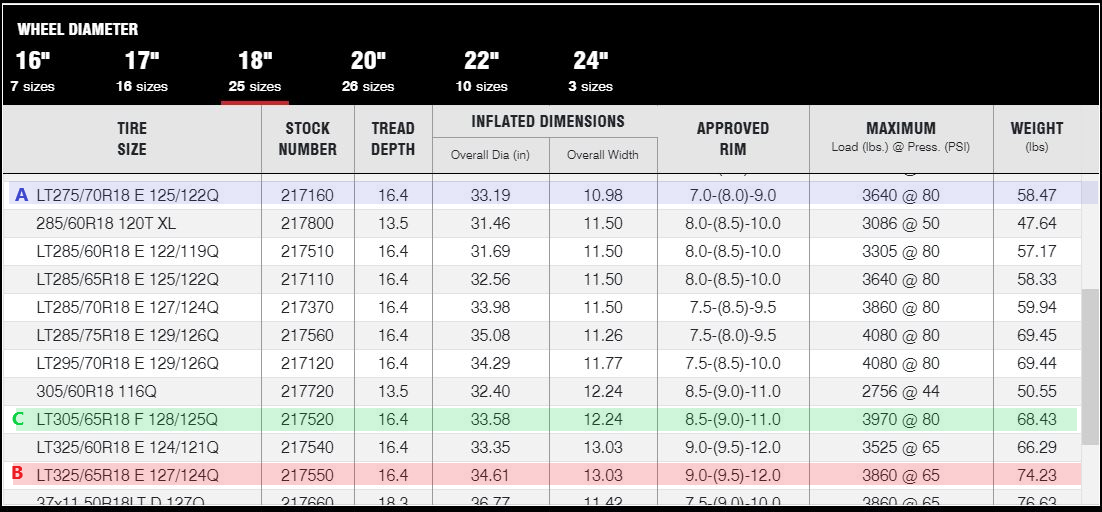AH_AK
Apr 11, 2021Explorer
Tires (the weakest link)
Like every other truck camper owner, I am looking to increase the safe load carrying capacity of my truck (2012 Chevy 3500HD SRW). I get that you can't increase the payload, but I also know that 90% of TC's on the road are overloaded (some egregiously) and you don't hear a lot about catastrophic failures. I imagine this is likely thanks to the healthy factor of safety that auto- and tire-makers build into their designs. Perhaps the nature of heavy haul driving (slow, cautious) helps to provide an additional buffer.
When I looked into the limiting factor for the payload, it appears to be the tires. The wheels, axles, suspension, and brakes all seem capable of handling a larger GVWR/GAWRR. Handling (sway, squat, etc.) is a different beast, but can be addressed with upgrades. So here is the rub (pun intended), my truck is very limited in terms of upsizing the tires ( with the intention of bumping the load index). I considered Rickson 19.5x6.75 wheels with 225/70r19.5 G or H tires, but Rickson is sort of MIA in terms of communications...also $$$. Vision wheels would be great, but the 19.5x7.5's can only run 245/70r19.5 and I am told they will rub...also $$$.
So I start looking for load range F tires in the stock size (265/70r18) and I find that one company makes them https://www.prioritytire.com/kanati-armor-hog-atx-lt-265-70r18-127-124q-f-12-ply-at-a-t-all-terrain-tire/. Now these get me to a load index of 127, which I am satisfied with, but they have a speed rating of Q (99mph). No worries, I am not planning on racing around with my TC. Looking at S-rated (112 mph) tires, the absolute largest I can fit without lifting the truck is 275/70r18, and the load index is only 125 on these.
This gets me thinking about the basis for the load index and I find this http://www.trucktrend.com/how-to/towing/1407-understanding-tire-load-ratings. Apparently, it is based on temperature, which is a function of load, speed, materials/mass, pressure, and ambient conditions. So hypothetically, if I commit to never driving faster than 60 mph, would I actually have a greater factor of safety on the 125 index, S-rated tires due to the additional speed margin? I wonder if these calculations are done by tire makers using models, or, if they physically test every model.
Now before you all light me up: YES, I know I could buy a dually. YES, I know I could buy a smaller camper. YES, I know I can reduce the driving weight by emptying tanks and lightening my gear load. YES, I know that I can just relax and the extra 200-300 lb per tire probably won't kill me and my family. I am genuinely curious as to what these tires can handle practically speaking. I also believe that the more you know about the likely cause of failure (e.g. overheating) the better you can manage you operations to mitigate risks (e.g. drive slow/empty tanks when it is hot).
The tread on those Kanati's is probably going to wear fast, but the steel construction and the increased load index are awfully tempting. Plus, I don't need to solve the Rickson puzzle to actually buy them. What say ye?
When I looked into the limiting factor for the payload, it appears to be the tires. The wheels, axles, suspension, and brakes all seem capable of handling a larger GVWR/GAWRR. Handling (sway, squat, etc.) is a different beast, but can be addressed with upgrades. So here is the rub (pun intended), my truck is very limited in terms of upsizing the tires ( with the intention of bumping the load index). I considered Rickson 19.5x6.75 wheels with 225/70r19.5 G or H tires, but Rickson is sort of MIA in terms of communications...also $$$. Vision wheels would be great, but the 19.5x7.5's can only run 245/70r19.5 and I am told they will rub...also $$$.
So I start looking for load range F tires in the stock size (265/70r18) and I find that one company makes them https://www.prioritytire.com/kanati-armor-hog-atx-lt-265-70r18-127-124q-f-12-ply-at-a-t-all-terrain-tire/. Now these get me to a load index of 127, which I am satisfied with, but they have a speed rating of Q (99mph). No worries, I am not planning on racing around with my TC. Looking at S-rated (112 mph) tires, the absolute largest I can fit without lifting the truck is 275/70r18, and the load index is only 125 on these.
This gets me thinking about the basis for the load index and I find this http://www.trucktrend.com/how-to/towing/1407-understanding-tire-load-ratings. Apparently, it is based on temperature, which is a function of load, speed, materials/mass, pressure, and ambient conditions. So hypothetically, if I commit to never driving faster than 60 mph, would I actually have a greater factor of safety on the 125 index, S-rated tires due to the additional speed margin? I wonder if these calculations are done by tire makers using models, or, if they physically test every model.
Now before you all light me up: YES, I know I could buy a dually. YES, I know I could buy a smaller camper. YES, I know I can reduce the driving weight by emptying tanks and lightening my gear load. YES, I know that I can just relax and the extra 200-300 lb per tire probably won't kill me and my family. I am genuinely curious as to what these tires can handle practically speaking. I also believe that the more you know about the likely cause of failure (e.g. overheating) the better you can manage you operations to mitigate risks (e.g. drive slow/empty tanks when it is hot).
The tread on those Kanati's is probably going to wear fast, but the steel construction and the increased load index are awfully tempting. Plus, I don't need to solve the Rickson puzzle to actually buy them. What say ye?
